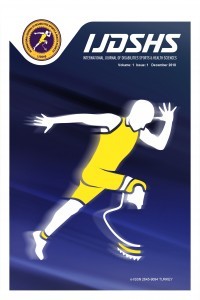Mohan Kumar PASUPULETİ, Divya Naga Lakshmi P, Jyothirmai KONERU, Swathi P, Karteek Varma PV, Sai Amulya KUKUTLA
Assessment of Impact of new work postures adaptations of dentists on musculoskeletal discomfort by RULA and QEC
Anahtar Kelimeler:
Conventional dental chair; dental institute; dental surgeons; proprioceptive derivation; musculoskeletal disorders; work postures., dental institute, dental surgeons, proprioceptive derivation, musculoskeletal discomfort, work postures
Assessment of Impact of new work postures adaptations of dentists on musculoskeletal discomfort by RULA and QEC
Objective: The concept on which the health care system is based is widely called Pd (proprioceptive derivation) or dp (derivations from proprioception) or “0” (zero) concept, centering on the positions, movements, contacts, and discomfort that we sense within our bodies as both providers and receivers of care. During the 1970s, Pd was used for health care records and skill acquisition, which can be applied anywhere in the world. The goal of this study was to evaluate and compare the impact of dental professionals' work postures on musculoskeletal problems by following Rapid Upper Limb Assessment (RULA) and Quick Exposure Check (QEC) while using conventional and proprioceptive derivation methodologies. Methodology: A questionnaire based study on dental clinicians' work postures analysis in dental institute and a symptom survey among dental clinicians working on both conventional and proprioceptive derivation ideas are the primary components of the study. Results: When musculoskeletal diseases among dental surgeons are compared between conventional and Pd work postures, a significant difference are detected. When asked if they felt any physical discomfort when doing oral prophylaxis, almost all of the doctors in Pd position said no. 100% of the clinicians observed that they applied the least force for scaling and polishing in PD posture. Conclusion: Adapting and practicing proprioceptive derived work postures resulted in less discomfort and least possible work-related injuries among dentists.
Keywords:
Conventional dental CHAIR, dental institute, dental surgeons, proprioceptive derivation, musculoskeletal discomfort, work postures,
___
- Abdolalizadeh M, Jahanimoghadam F. (2015). Musculoskeletal Disorders in Dental Practitioners and Ergonomic Strategies. ASJ, 12(4) :161-6.
- Aman JE, ElangovanN, YehI-L, Konczak J. (2015). The effectiveness of proprioceptive training for improving motor function: A systematic review. Front. Hum.Neurosci, 8:1075.
- B Ajay, D Poonam, S Vrinda, Shanthi G et al. (2013).Proprioceptive derivation concept-Implications in dentistry. J Indian Assoc Public Health Dent, 11(3):85-8.
- Belenky MM. (1998). Human-centered ergonomics: proprioceptive pathway to occupational health and peak performance in dental practice. In: Murphy. DC, editor. Ergonomics and the dental care worker. Washington, DC, USA: American Public Health Association, p. 275-99.
- Blanc D, Farre P, Hamel O. (2014). Variability of musculoskeletal strain on dentists: An electromyographic and goniometric study. Int J Occup Saf Ergon, 20(2):295-307.
- Chaikumarn, M. (2004). Working conditions and dentists' attitude towards proprioceptive derivation. Int J Occup Saf Ergon, 10(2):137-46.
- Chaikumarn, M. (2005). Differences in dentists’ working postures when adopting proprioceptive derivation vs. conventional concept. Int J Occup Saf Ergon, 11(4), 441-449.
- Custodio, R.; Silva, C.; Brandão, J. (2012). Ergonomics work analysis applied to dentistry-A Brazilian case study. Work, 41:690-7,
- Gandavadi, A., (2008). Working postures in dental practitioners and dental students: relationships between posture, seating, and muscle activity (Doctoral dissertation, University of Birmingham).
- García-Vidal JA, López-Nicolás M, Sánchez-Sobrado AC, Escolar-Reina MP, Medina-Mirapeix F, Bernabeu-Mora R. (2019). The Combination of Different Ergonomic Supports during Dental Procedures Reduces the Muscle Activity of the Neck and Shoulder. J Clin Med, 8(8):1230.
- Hendrick HW. (2003). Determining the cost–benefits of ergonomics projects and factors that lead to their success. Applied ergonomics, 34(5):419-27.
- Kumar PM, Sahitya S, Penmetsa GS, et al. (2020). Assessment of knowledge, attitude, and practice related to ergonomics among the students of three different dental schools in India: An original research. J Educ Health Promot, 9:266
- Lietz J, Kozak A, Nienhaus A. (2018). Prevalence and occupational risk factors of musculoskeletal diseases and pain among dental professionals in Western countries: A systematic literature review and meta-analysis. PLoS One, 13(12):e0208628.
- López-Nicolás M, García-Vidal JA, Medina-Mirapeix F, et al. (2019). Effect of different ergonomic supports on muscle activity of dentists during posterior composite restoration. Peer J, 7: e8028.
- Nowak J, Erbe C, Hauck I, et al. (2016). Motion analysis in the field of dentistry: a kinematic comparison of dentists and orthodontists. BMJ Open, 6(8):e011559.
- Nguyen BD. (2004).Musculoskeletal problems and occupational stress among dentists and dental assistants in a dental clinic. National Institute of Occupational and EnvironmentalHealth,Vietnam.Occup Environ Med, 61:e57.
- Ohlendorf D, Erbe C, Hauck I, et al. (2017). Restricted posture in dentistry - a kinematic analysis of orthodontists. BMC Musculo skelet Disord,18(1):275.
- Pasupuleti, M.K. (2023). Strengthening occupational health by proprioceptive derivation in dentistry: a systematic review. Theor. Issues Ergon. Sci, 24(1), 17-28.
- Pîrvu, C.; Pătraşcu, I.; Pîrvu, D.; Ionescu, C. (2014). The dentist’s operating posture-Ergonomic aspects. J. Med. Life,7:177-82.
- Pollack R. (1996). Dental office ergonomics: how to reduce stress factors and increase efficiency. J Can Dent Assoc, 62(6):508-10.
- Terui Y, Iwao J, Taniguchi T. (1997).The effect of the SATV system. In: Seppälä P, Luopajärvi T, Nygård CH, Mattila M, editors. Proceedings of the 13th Triennial Congress of the International Ergonomics Association, Tampere, Finland. Helsinki, Finland: Finnish Institute of Occupational Health, vol. 6, p. 244–6.
- Yayın Aralığı: Yılda 3 Sayı
- Başlangıç: 2018
- Yayıncı: Nevzat DEMİRCİ
Sayıdaki Diğer Makaleler
İsmail AYDIN, İbrahim GÜMÜŞBOĞA
Halil İbrahim BULGUROĞLU, Merve BULGUROĞLU, Cansu GEVREK, Serenay ZORLU, Sezen DİNCER, Kübra KENDAL
Determination of Anthropometric Measurements and Nutritional Status of Wheelchair Basketball Players
Ayşe Hümeyra İSLAMOĞLU, Esra ÖNDAR, Tuğçe YILDIRIM, Zehra KARTAL
Berivan Beril KILIÇ, Hakan AKGÜL, Eren TİMURTAŞ, Aysel YILDIZ ÖZER
Does Function Level of Individuals With Autism Spectrum Disorder Affect The Family Impact?
Nazan ÖZTÜRK, Gül Öznur KARABIÇAK, Uğur CAVLAK
Manolya ACAR, Demet ÖZTÜRK, Kübra Nur DOĞAN, İpek ADA, Didem Nur DEMİRER
Sebelasmaret Boccia Throw Test (SBTT) Instrument Development
